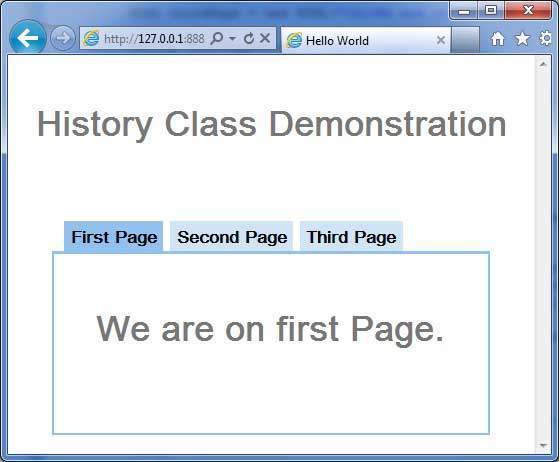GWT 历史
GWT 应用程序通常是运行 JavaScript 的单页应用程序,并且不包含大量页面,因此浏览器不会跟踪用户与应用程序的交互。要使用浏览器的历史记录功能,应用程序应为每个可导航页面生成唯一的 URL 片段。
GWT 提供了
历史机制来处理这种情况。
GWT 使用一个术语
token,它只是一个字符串,应用程序可以解析它以返回到特定状态。应用程序会将此令牌作为 URL 片段保存在浏览器的历史记录中。
例如,一个名为"pageIndex1"的历史标记将被添加到一个 URL 中,如下所示-
http://www.tutorialspoint.com/HelloWorld.html#pageIndex0
历史管理工作流程
第 1 步-启用历史记录支持
为了使用 GWT History 支持,我们必须首先将以下 iframe 嵌入到我们的主机 HTML 页面中。
<iframe src = "javascript:''"
id = "__gwt_historyFrame"
style = "width:0;height:0;border:0"></iframe>
第 2 步-将令牌添加到历史记录
以下示例统计如何将令牌添加到浏览器历史记录
int index = 0;
History.newItem("pageIndex" + index);
第 3 步-从历史中检索令牌
当用户使用浏览器的后退/前进按钮时,我们将检索令牌并相应地更新我们的应用程序状态。
History.addValueChangeHandler(new ValueChangeHandler<String>() {
@Override
public void onValueChange(ValueChangeEvent<String> event) {
String historyToken = event.getValue();
/* parse the history token */
try {
if (historyToken.substring(0, 9).equals("pageIndex")) {
String tabIndexToken = historyToken.substring(9, 10);
int tabIndex = Integer.parseInt(tabIndexToken);
/* select the specified tab panel */
tabPanel.selectTab(tabIndex);
} else {
tabPanel.selectTab(0);
}
} catch (IndexOutOfBoundsException e) {
tabPanel.selectTab(0);
}
}
});
现在让我们看看正在运行的历史类。
历史课-完整示例
此示例将带您通过简单的步骤来演示 GWT 应用程序的历史管理。按照以下步骤更新我们在
GWT-创建应用程序章节中创建的 GWT 应用程序-
| 步骤 |
描述 |
| 在com.tutorialspoint 包下创建一个名为HelloWorld 的项目,如GWT-创建应用程序 章节所述。 |
| 将HelloWorld.gwt.xml、HelloWorld.css、HelloWorld.html和HelloWorld.java修改为下面解释。保持其余文件不变。 |
| 编译并运行应用程序以验证实现逻辑的结果。 |
以下是修改后的模块描述符
src/com.tutorialspoint/HelloWorld.gwt.xml的内容。
<?xml version = "1.0" encoding = "UTF-8"?>
<module rename-to = 'helloworld'>
<!--Inherit the core Web Toolkit stuff. -->
<inherits name = 'com.google.gwt.user.User'/>
<!--Inherit the default GWT style sheet. -->
<inherits name = 'com.google.gwt.user.theme.clean.Clean'/>
<!--Specify the app entry point class. -->
<entry-point class = 'com.tutorialspoint.client.HelloWorld'/>
<!--Specify the paths for translatable code -->
<source path = 'client'/>
<source path = 'shared'/>
</module>
以下是修改后的样式表文件
war/HelloWorld.css的内容。
body {
text-align: center;
font-family: verdana, sans-serif;
}
h1 {
font-size: 2em;
font-weight: bold;
color: #777777;
margin: 40px 0px 70px;
text-align: center;
}
以下是修改后的HTML主机文件
war/HelloWorld.html
的内容
<html>
<head>
<title>Hello World</title>
<link rel = "stylesheet" href = "HelloWorld.css"/>
<script language = "javascript" src = "helloworld/helloworld.nocache.js">
</script>
</head>
<body>
<iframe src = "javascript:''"id = "__gwt_historyFrame"
style = "width:0;height:0;border:0"></iframe>
<h1> History class Demonstration</h1>
<div id = "gwtContainer"></div>
</body>
</html>
让我们有以下 Java 文件
src/com.tutorialspoint/HelloWorld.java 的内容,我们将使用它来演示 GWT 代码中的历史管理。
package com.tutorialspoint.client;
import com.google.gwt.core.client.EntryPoint;
import com.google.gwt.event.logical.shared.SelectionEvent;
import com.google.gwt.event.logical.shared.SelectionHandler;
import com.google.gwt.event.logical.shared.ValueChangeEvent;
import com.google.gwt.event.logical.shared.ValueChangeHandler;
import com.google.gwt.user.client.History;
import com.google.gwt.user.client.ui.HTML;
import com.google.gwt.user.client.ui.RootPanel;
import com.google.gwt.user.client.ui.TabPanel;
public class HelloWorld implements EntryPoint {
/**
* this is the entry point method.
*/
public void onModuleLoad() {
/* create a tab panel to carry multiple pages */
final TabPanel tabPanel = new TabPanel();
/* create pages */
HTML firstPage = new HTML("<h1>We are on first Page.</h1>");
HTML secondPage = new HTML("<h1>We are on second Page.</h1>");
HTML thirdPage = new HTML("<h1>We are on third Page.</h1>");
String firstPageTitle = "First Page";
String secondPageTitle = "Second Page";
String thirdPageTitle = "Third Page";
tabPanel.setWidth("400");
/* add pages to tabPanel*/
tabPanel.add(firstPage, firstPageTitle);
tabPanel.add(secondPage,secondPageTitle);
tabPanel.add(thirdPage, thirdPageTitle);
/* add tab selection handler */
tabPanel.addSelectionHandler(new SelectionHandler<Integer>() {
@Override
public void onSelection(SelectionEvent<Integer> event) {
/* add a token to history containing pageIndex
History class will change the URL of application
by appending the token to it.
*/
History.newItem("pageIndex" + event.getSelectedItem());
}
});
/* add value change handler to History
this method will be called, when browser's
Back button or Forward button are clicked
and URL of application changes.
*/
History.addValueChangeHandler(new ValueChangeHandler<String>() {
@Override
public void onValueChange(ValueChangeEvent<String> event) {
String historyToken = event.getValue();
/* parse the history token */
try {
if (historyToken.substring(0, 9).equals("pageIndex")) {
String tabIndexToken = historyToken.substring(9, 10);
int tabIndex = Integer.parseInt(tabIndexToken);
/* select the specified tab panel */
tabPanel.selectTab(tabIndex);
} else {
tabPanel.selectTab(0);
}
} catch (IndexOutOfBoundsException e) {
tabPanel.selectTab(0);
}
}
});
/* select the first tab by default */
tabPanel.selectTab(0);
/* add controls to RootPanel */
RootPanel.get().add(tabPanel);
}
}
一旦您准备好完成所有更改,让我们像在GWT-创建应用程序一章中所做的那样,在开发模式下编译和运行应用程序。如果您的应用程序一切正常,这将产生以下结果-
 现在点击每个标签来选择不同的页面。
您应该注意到,当每个选项卡被选中时,应用程序 url 都会发生变化,并且 #pageIndex 被添加到 url 中。
您还可以看到浏览器的后退和前进按钮现在已启用。
使用浏览器的后退和前进按钮,您会看到相应地选择了不同的标签。
现在点击每个标签来选择不同的页面。
您应该注意到,当每个选项卡被选中时,应用程序 url 都会发生变化,并且 #pageIndex 被添加到 url 中。
您还可以看到浏览器的后退和前进按钮现在已启用。
使用浏览器的后退和前进按钮,您会看到相应地选择了不同的标签。
 现在点击每个标签来选择不同的页面。
您应该注意到,当每个选项卡被选中时,应用程序 url 都会发生变化,并且 #pageIndex 被添加到 url 中。
您还可以看到浏览器的后退和前进按钮现在已启用。
使用浏览器的后退和前进按钮,您会看到相应地选择了不同的标签。
现在点击每个标签来选择不同的页面。
您应该注意到,当每个选项卡被选中时,应用程序 url 都会发生变化,并且 #pageIndex 被添加到 url 中。
您还可以看到浏览器的后退和前进按钮现在已启用。
使用浏览器的后退和前进按钮,您会看到相应地选择了不同的标签。